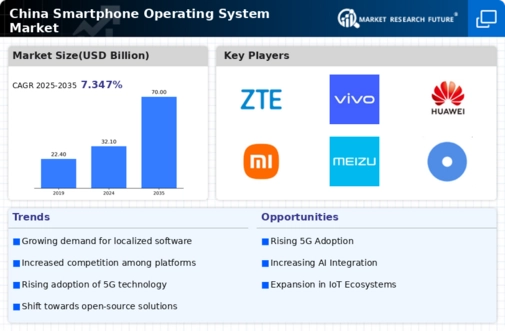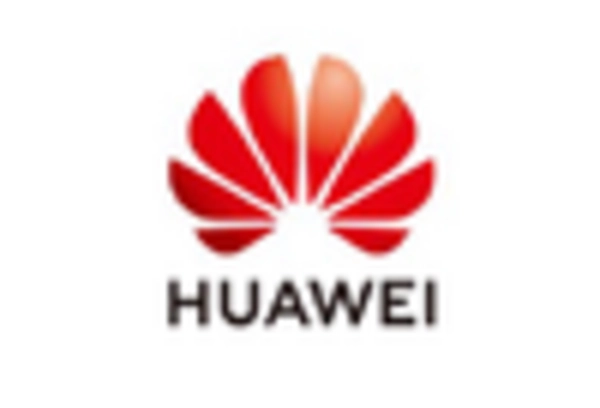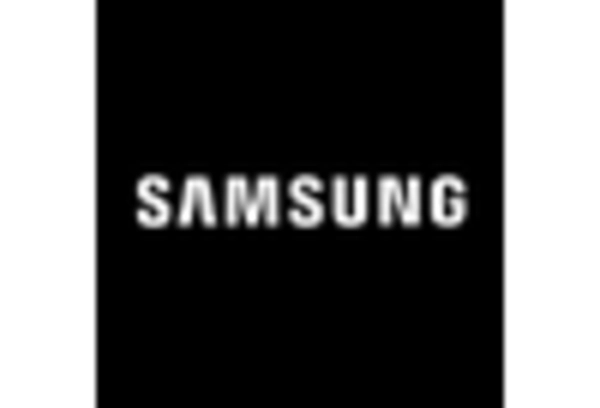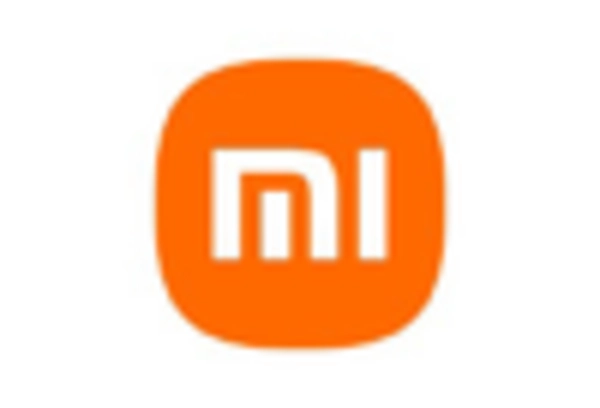Growing Demand for 5G Technology
The smartphone operating-system market in China is experiencing a notable surge in demand for 5G technology. As 5G networks become increasingly prevalent, consumers are seeking devices that can fully leverage this advanced connectivity. This trend is prompting operating system developers to optimize their platforms for enhanced performance and speed. In 2025, it is estimated that over 60% of smartphone users in China will own 5G-compatible devices, necessitating operating systems that can support the unique features of 5G. Consequently, manufacturers are investing heavily in R&D to create systems that can handle higher data rates and lower latency, thereby driving innovation within the smartphone operating-system market. This growing demand for 5G is likely to shape the competitive landscape, as companies strive to offer superior user experiences that capitalize on the capabilities of next-generation networks.
Increased Focus on Cybersecurity
As digital threats continue to evolve, the smartphone operating-system market in China is witnessing a growing emphasis on cybersecurity. Consumers are becoming more aware of the risks associated with data breaches and privacy violations, leading to a demand for operating systems that prioritize security features. In 2025, it is projected that nearly 70% of smartphone users in China will consider security as a critical factor when choosing an operating system. This shift is prompting developers to integrate advanced security protocols, such as biometric authentication and end-to-end encryption, into their platforms. Furthermore, regulatory bodies are likely to impose stricter guidelines on data protection, compelling operating system providers to enhance their security measures. This heightened focus on cybersecurity not only influences consumer preferences but also drives competition among developers to create the most secure operating systems in the smartphone operating-system market.
Expansion of Smart Device Ecosystems
the smartphone operating-system market in China is witnessing an expansion of smart device ecosystems. As consumers increasingly adopt smart home technologies and IoT devices, there is a growing expectation for operating systems to provide seamless integration across various platforms. In 2025, it is anticipated that over 50% of smartphone users in China will utilize multiple smart devices, creating a demand for operating systems that can facilitate interoperability. This trend is encouraging developers to create ecosystems that allow for smooth communication between smartphones, wearables, and home automation systems. Consequently, operating systems that can effectively manage and synchronize these devices are likely to gain a competitive edge in the smartphone operating-system market. This expansion not only enhances user convenience but also drives innovation as companies strive to create cohesive and interconnected experiences for consumers.
Rise of E-commerce and Mobile Payments
The smartphone operating-system market in China is significantly influenced by the rapid growth of e-commerce and mobile payment solutions. With the increasing adoption of online shopping and digital transactions, consumers are seeking operating systems that seamlessly integrate e-commerce functionalities. In 2025, it is estimated that over 80% of smartphone users in China will engage in mobile payments, necessitating operating systems that support secure and efficient transaction processes. This trend is prompting developers to collaborate with financial institutions and e-commerce platforms to enhance their systems' capabilities. Additionally, the integration of features such as digital wallets and loyalty programs is becoming essential for attracting users. As a result, the smartphone operating-system market is evolving to accommodate the demands of a digitally-savvy consumer base, driving innovation and competition among operating system providers.
Emergence of Customization and Personalization Features
The smartphone operating-system market in China is increasingly characterized by the emergence of customization and personalization features. As consumers seek unique experiences tailored to their preferences, operating systems are evolving to offer greater flexibility in design and functionality. In 2025, it is projected that around 65% of smartphone users in China will prioritize customization options when selecting an operating system. This trend is prompting developers to implement features that allow users to modify interfaces, themes, and app layouts according to their individual tastes. Additionally, the integration of AI-driven recommendations for app usage and settings is becoming more prevalent, enhancing the personalization aspect. As a result, the smartphone operating-system market is likely to see intensified competition among providers striving to deliver the most adaptable and user-friendly platforms.

















Leave a Comment